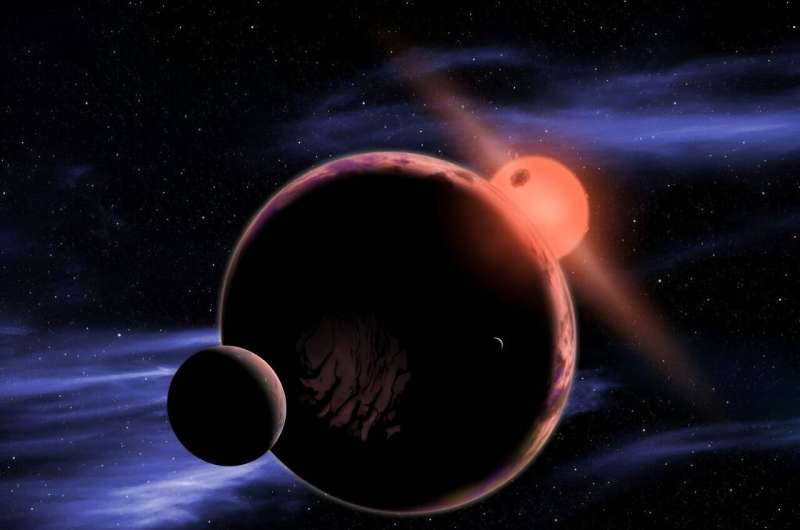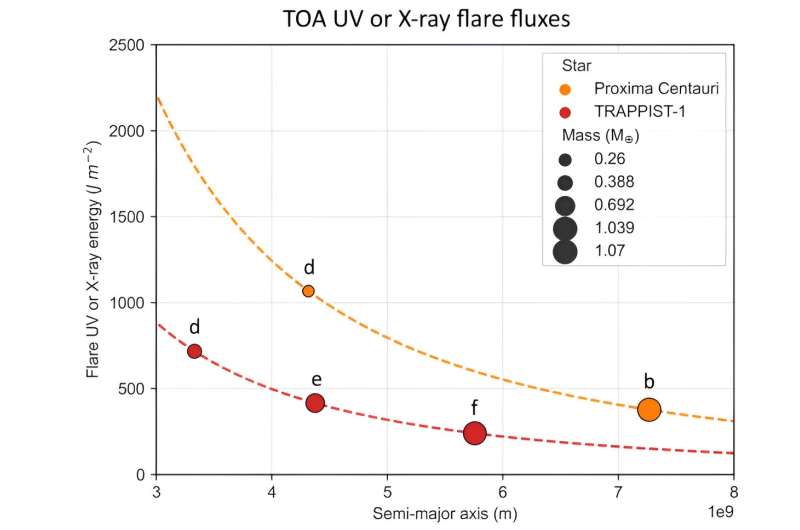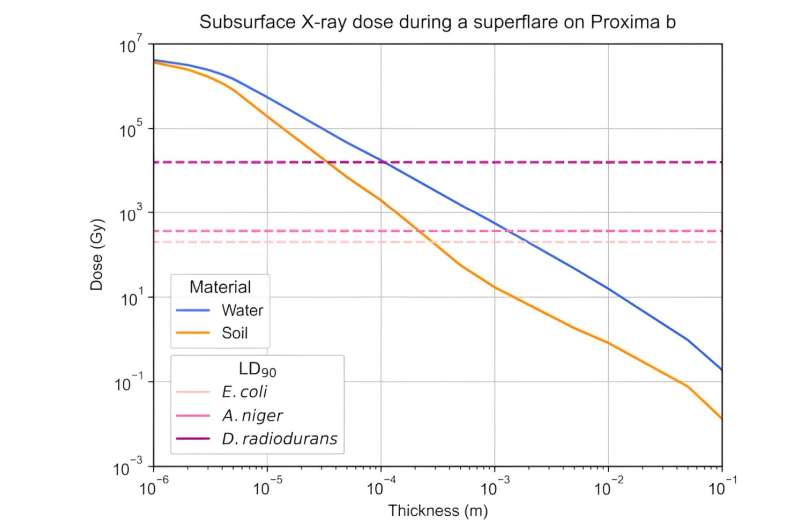This article has been reviewed according to Science X's editorial process and policies. Editors have highlighted the following attributes while ensuring the content's credibility:
fact-checked
peer-reviewed publication
trusted source
proofread
Could Earth life survive on a red dwarf planet?

Even though exoplanet science has advanced significantly in the last decade or two, we're still in an unfortunate situation. Scientists can only make educated guesses about which exoplanets may be habitable. Even the closest exoplanet is four light-years away, and though four is a small integer, the distance is enormous.
That doesn't stop scientists from trying to piece things together, though.
One of the most consequential questions in exoplanet science and habitability concerns red dwarfs. Red dwarfs are plentiful, and research shows that they host multitudes of planets. While gas giants like Jupiter are comparatively rare around red dwarfs, other planets are not. Observational data shows that about 40% of red dwarfs host super-Earth planets in their habitable zones.
Red dwarfs have a few things going for them when it comes to exoplanet habitability. These low-mass stars have extremely long lifespans, meaning the energy output is stable for long periods of time. As far as we can tell, that's a benefit for potential habitability and the evolution of complex life. Stability gives life a chance to respond to changes and persist in their niches.
But red dwarfs have a dark side, too: flaring. All stars flare to some degree, even our sun. But the sun's flaring is not even in the same league as red dwarf flaring. Red dwarfs can flare so powerfully that they can double their brightness in a very short period of time. Is there any way life could survive on red dwarf planets?
New research from scientists in Portugal and Germany examines that question. To test the idea of red dwarf exoplanet habitability, the researchers used a common type of mold and subjected it to simulated red dwarf radiation, protected only by a simulated Martian atmosphere.
The research is "How habitable are M-dwarf Exoplanets? Modelling surface conditions and exploring the role of melanins in the survival of Aspergillus niger spores under exoplanet-like radiation." The lead author is Afonso Mota, an astrobiologist at the Aerospace Microbiology Research Group in the Institute of Aerospace Medicine at the German Aerospace Center (DLR.) The paper has been submitted to the journal Astrobiology and is currently available on the preprint server arXiv.

Aspergillus niger is ubiquitous in soil and is commonly known for the black mold it can cause on some fruits and vegetables. It's also a prolific producer of melanin. Melanin absorbs light very efficiently, and in humans, melanin is produced by exposure to UV radiation and darkens the skin. Melanins are widespread in nature, and extremophiles use them to protect themselves. Melanin can dissipate up to 99.9% of absorbed UV. Scientists think that the appearance of melanins may have played a critical role in the development of life on Earth by protecting organisms from the sun's harmful radiation.
In essence, this research asks a pretty simple question. Can Aspergillus niger's melanin help it survive red dwarf flaring when protected by a thin atmosphere like Mars'?
Proxima Centauri and TRAPPIST-1 are both well-known red dwarfs in exoplanet science because they host rocky exoplanets in their habitable zones. This study zeroes in on Proxima Centauri b (PCb hereafter) and TRAPPIST-1 e (T1e hereafter.) They're both likely to have temperatures that allow liquid water to exist on their surfaces, given the right atmospheric properties. Both PCb and T1e likely have tolerable radiation environments, as well.
It's impossible to model the surface conditions of these planets perfectly, but researchers can get close by using what's called the equilibrium temperature. Measuring stellar flaring is easier because it can be observed accurately from great distances. Melanin production in A. niger is likewise well understood. By working with all three factors, the researchers were able to model how the mold would fare on the surface of a habitable zone planet around a red dwarf.
"In the context of astrobiology, and particularly astromycology, the study of extremotolerant fungi has proven critical to better understanding the limits of life and habitability," the authors write. "Aspergillus niger, an extremotolerant filamentous fungus, has been frequently used as a model organism for studying fungal survival in extreme environments, growing in a wide range of conditions."
A. niger's spores have a complex and dense coating of melanin that protects them from UV and X-ray radiation. They've been found in the International Space Station, a testament to their ability to withstand some of the hazards in space. Though they're terrestrial, scientists can use them to study the potential habitability of exoplanets.
In this work, the researchers tested the survivability of A. niger spores in simulated surface conditions of PCb and T1c, where the red dwarf stars bathe the planetary surfaces in powerful UV and X-ray radiation.

The researchers tested different types of A. niger spores in different solutions. One was a wild strain, one was a mutant strain modified to produce and excrete pyomelanin, one of the melanins of particular interest to scientists, and the third was a melanin-deficient strain. The spores were suspended in either saline solutions, melanin-rich solutions, or a control solution for a period of time while being exposed to different amounts of both X-ray and UV radiation.
After exposure, the three types of A. niger spores were tested for their survivability and viability.
The results show that A. niger would be able to survive the intense radiation environments that can sterilize the surfaces of red dwarf exoplanets. Not if directly exposed, but if under only a few millimeters of soil or water. "If unattenuated, X-rays from flares would most likely sterilize the surface of all studied exoplanets. However, microorganisms suited to survive under the surface would be unaffected by most exogenous radiation sources under a few millimeters of soil or water," the researchers explain.
What the study comes down to is melanin. The more melanin there is, the higher the survival rate for A. niger.
"The experiments performed in this study corroborate the multifunctional purpose of melanin since A. niger MA93.1 spores germinated faster and more efficiently in a melanin-rich extract when compared to the two control solutions," the authors write. A. niger MA93.1 is the mutant strain modified to produce and excrete melanin.
For the exoplanets T1e and PCb, the research is promising for those of us hoping for habitability on other planets. When it comes to UV-C radiation, a significant fraction of spores from samples containing melanin could survive the superflares striking PCb and T1e, even with very little atmospheric shielding. Exposure to X-rays was similar.
While we all like to imagine complex life elsewhere in the universe, we're more likely to stumble on worlds nothing like Earth. If we find life, it'll probably be simple organisms that are finding a way to survive in what we would consider marginal or extreme environments. Since red dwarfs are so common, that's likely where we'll find this life.
This study bolsters that idea.
"Furthermore," the authors write in their conclusion, "results from this work showed how A. niger, like other extremotolerant and extremophilic organisms, would be able to survive harsh radiation conditions on the surface of some M-dwarf exoplanets."
The melanin plays a critical role in their potential survival, the authors conclude. "Additionally, melanin-rich solutions were shown to be highly beneficial to the survival and germination of A. niger spores, particularly when treated with high doses of UV and X-ray radiation."
There's an ongoing scientific discussion around red dwarf exoplanet habitability, with flaring playing a prominent role. But this research shows maybe it's too soon to write red dwarfs off while also shedding light on how life on Earth may have got going.
"These results offer an insight into how lifeforms may endure harmful events and conditions prevalent on exoplanets and how melanin may have had a role in the origin and evolution of life on Earth and perhaps on other worlds."
More information: Afonso Mota et al, How habitable are M-dwarf Exoplanets? Modeling surface conditions and exploring the role of melanins in the survival of Aspergillus niger spores under exoplanet-like radiation, arXiv (2024). DOI: 10.48550/arxiv.2403.03403
Journal information: Astrobiology , arXiv
Provided by Universe Today




















